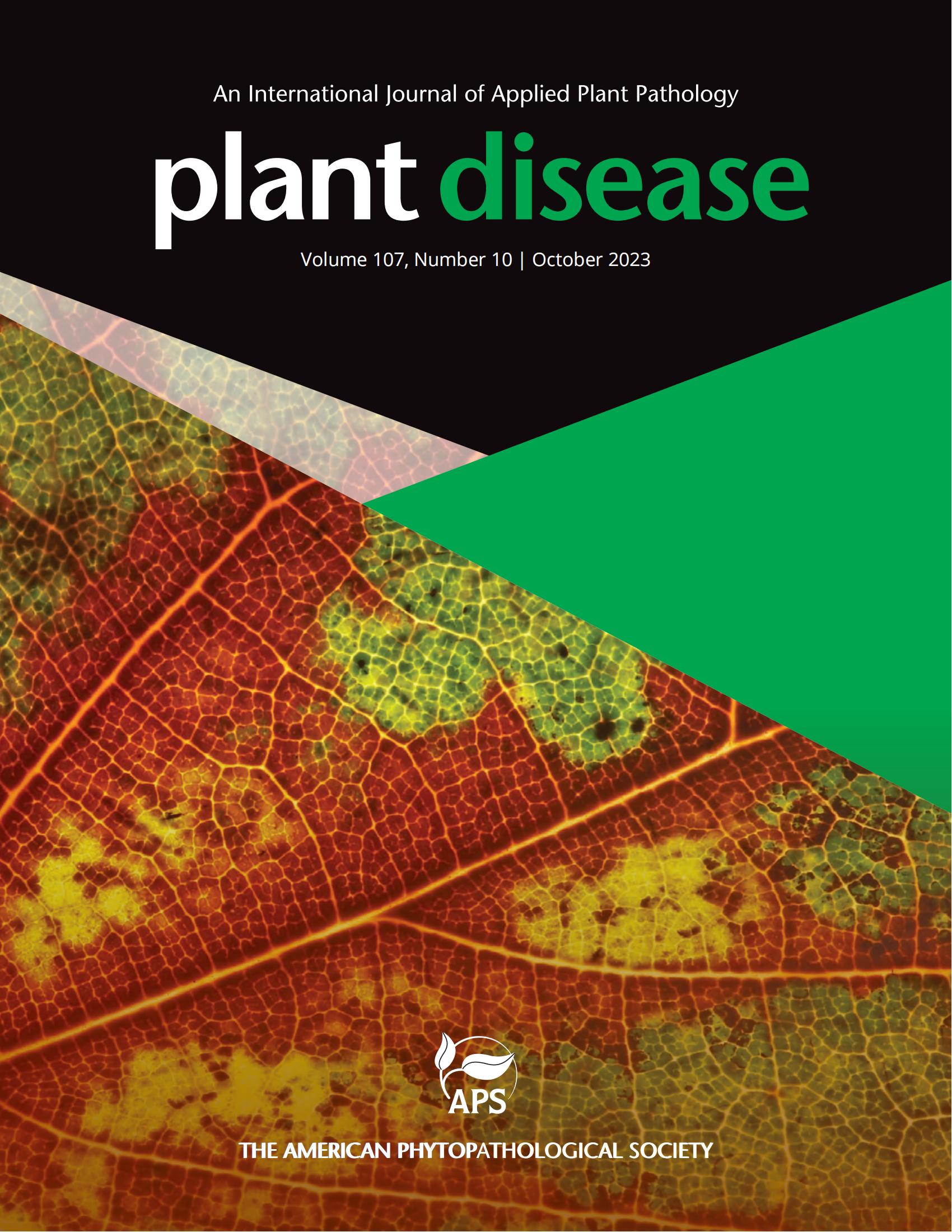意大利首次记录西瓜皱叶相关病毒2型在露地感染西瓜。
摘要
西瓜(Citrullus lanatus L.)是意大利重要的园艺作物,每年产量约60万吨(欧洲第三大生产国)。病毒被认为是西瓜生产的一个限制因素,尤其是那些由白蝇和蚜虫等有效载体传播的病毒。2023年7月,100%的西瓜植株(cv。在Eboli (Salerno province, South Italy)约4000平方米的商业田里,观察到桑巴(Samba),包括卷曲和褶皱,黄色斑纹和褪绿。坐标:北纬40°29′83”东经14°57′99”)(图S1)。一些水果也有症状,表现为圆形病变和变形。总的来说,症状类似于西瓜皱叶相关病毒(WCLaV-1,瓜病毒和WCLaV-2,瓜病毒);Coguvirus属,phenuivirus科)(Hernandez et al., 2021;Hendricks et al., 2022;Mulholland et al., 2023)。使用Viral Gene-spinTM病毒DNA/RNA提取试剂盒(iNtRON Biotechnology, Inc., South Korea)从10株有症状植物的叶片组织中分离总RNA,并用于构建RNA-seq文库,在Illumina Novaseq 6000平台上测序,配对末端reads长度为101 bp。HTS产生了31,125,612个原始读取,而修剪后恢复了28,868,089个读取。利用SPAdes程序(v. 3.15.3;Bankevich et al., 2012)。得到两组过滤后的contigs:在Metaspades中实现的算法得到3184个contigs,在RNAviral中实现的算法得到3369个contigs。在在线数据库(https://blast.ncbi.nlm.nih.gov/Blast.cgi)中对基因组进行BLASTn/BLASTx分析。分别从RNA1的7520个reads和RNA2的4585个reads中获得的两个contigs显示出与WCLaV-2基因组最大的核苷酸一致性。这些序列代表了相应病毒的全长基因组序列。HTS库未生成其他病毒的病毒contigs。利用wclav -2特异性引物WCLaV-2vRP(5′-GTCTCACATTCCTGCACTAACT)/WCLaV-2cRP(5′- atcggtcctgggttttgtatc)和WCLaV-2vMP(5′-GACTTCAGAACCTCAACATCCA)/WCLaV-2cMP(5′-CAAGGGAGAGTGCTGACAAA)分别靶向RdRP的968 bp和MP的562 bp,对10个西瓜样品的HTS结果进行RT-PCR验证(Hernandez et al., 2021)。对预期大小的扩增子进行测序,序列与HTS测序得到的相应区域100%相同,证实WCLaV-2在西瓜植物中存在。对5′和3′端序列进行验证后,两个基因组ssRNA片段的序列分别为RNA1的6679个核苷酸(nt)和RNA2的2729个核苷酸(nt)。这些序列以PQ869160 (RNA1)和PQ869161 (RNA2)的登录号存入GenBank。根据BLASTn分析,RNA1高度相似(99.94%序列同源;100%的查询覆盖率)与来自巴西的Ju-01-WCLaV2分离物(LC636073),而RNA2高度相似(96.23%的序列同源;99%查询覆盖率)到来自中国的KF-15分离株(NC_079049)。WCLaV-2首先在中国的西瓜中被报道(Xin等人,2017),然后在美国(Hernandez等人,2021),巴西(Maeda等人,2022)和澳大利亚(Mulholland等人,2023)。尽管最近在意大利的一些西瓜商业种子中检测到该病毒(Minutolo等人,2024年),但该报告首次证实该病毒在意大利南部露地西瓜作物中传播。应开展研究,评估病害对西瓜生产的发病率和影响,确定潜在的病媒和种子在病毒传播中的作用,以帮助制定最佳管理措施,以控制病毒造成的损害。Watermelon (Citrullus lanatus L.) is an important horticultural crop in Italy, with a production of around 600,000 tons per year (third producer in the Europe). Viruses are considered a limiting factor in watermelon production, especially those transmitted by efficient vectors such as whiteflies and aphids. In July 2023, foliar symptoms on 100% of watermelon plants (cv. Samba), including curling and wrinkling, yellow mottling and chlorosis, were observed in a commercial field of about 4000 m2 at Eboli (Salerno province, South Italy; coordinates: 40°29'83''N 14°57'99''E) (Figure S1). Some fruits were also symptomatic showing circular lesions and deformations. Overall, symptoms resembled those described for watermelon crinkle leaf-associated viruses (WCLaV-1, Coguvirus citrulli and WCLaV-2, Coguvirus henanense; genus Coguvirus, family Phenuiviridae) (Hernandez et al., 2021; Hendricks et al., 2022; Mulholland et al., 2023). Total RNAs were isolated from pooled leaf tissues of 10 symptomatic plants using the Viral Gene-spinTM Viral DNA/RNA Extraction Kit (iNtRON Biotechnology, Inc., South Korea) and used for construction of RNA-seq libraries, which were sequenced on an Illumina Novaseq 6000 platform with paired-end reads length of 101 bp. The HTS yielded 31,125,612 raw reads, while after trimming 28,868,089 reads were recovered. Viral genome assembly was performed with the two algorithms implemented in the SPAdes program (v. 3.15.3; Bankevich et al., 2012). Two sets of filtered contigs were obtained: 3,184 contigs with the algorithms implemented in Metaspades, and 3,369 contigs with algorithms implemented in RNAviral. BLASTn/BLASTx analysis of the contigs were carried out against online databases (https://blast.ncbi.nlm.nih.gov/Blast.cgi). Two contigs, obtained from the assembly of 7520 reads for RNA1 and 4585 reads for RNA2 respectively, showed the greatest nucleotide identities with the WCLaV-2 genome. These contigs represented full-length genomic sequences of the corresponding virus. No other viral contigs belonging to other viruses were generated by HTS library. The HTS results were confirmed by RT-PCR on each of the 10 watermelon samples using the WCLaV-2-specific primers WCLaV-2vRP (5'-GTCTCACATTCCTGCACTAACT)/WCLaV-2cRP (5'-ATCGGTCCTGGGTTATTTGTATC) targeting 968 bp of the RdRP and WCLaV-2vMP (5'-GACTTCAGAACCTCAACATCCA)/WCLaV-2cMP (5'-CAAGGGAGAGTGCTGACAAA) targeting 562 bp of the MP (Hernandez et al., 2021). Amplicons of the expected size were sequenced and sequences were 100% identical to the corresponding regions obtained by HTS sequencing, confirming presence of WCLaV-2 in the watermelon plants. After verifying the sequences at the 5' and 3' ends, the sequences of the two genomic ssRNA segments consisted of 6679 nucleotides (nt) for RNA1 and 2729 nt for RNA2. These sequences were deposited in GenBank with the accession numbers PQ869160 (RNA1) and PQ869161 (RNA2). According to the BLASTn analysis, the RNA1 was highly similar (99.94% sequence identity; 100% query coverage) to the Ju-01-WCLaV2 isolate (LC636073) from Brazil, while the RNA2 was highly similar (96.23% sequence identity; 99% query coverage) to the KF-15 isolate (NC_079049) from China. WCLaV-2 was first reported in watermelon in China (Xin et al., 2017) and then in USA (Hernandez et al. 2021), Brazil (Maeda et al., 2022) and Australia (Mulholland et al., 2023). Although it was recently detected in some watermelon commercial seeds in Italy (Minutolo et al., 2024), this report confirms for the first time the spread of the virus in open field watermelon crops in southern Italy. Studies to assess the incidence and impact of disease on watermelon production, the identification of potential vectors and the role of the seeds in virus transmission should be conducted to aid the development of the best management practices with the aim to contain the damages caused by the virus.

 求助内容:
求助内容: 应助结果提醒方式:
应助结果提醒方式:


